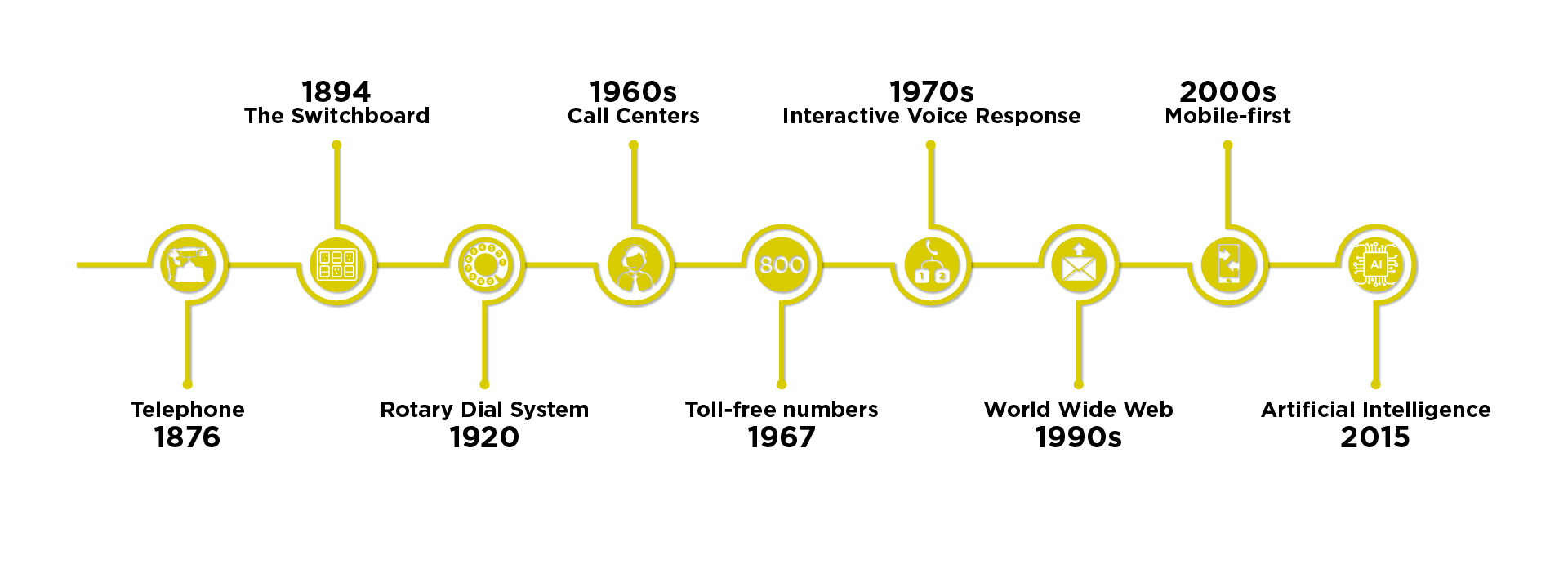The History of Customer Support
Customer Support: Where it all started
The history of customer support has been a long journey, benefitting both customers and companies. It all started with the first industrial revolution between 1760 and 1840. Initially, customer support consisted of walking to shops and factories or sending letters. If there was an issue or concern with a product or service, resolution was no easy task. These methods meant a problem couldn’t be resolved in a short time frame, and any follow-up only delayed the process further.
Coming towards the end of the 19th century, in approximately 1876, Alexander Graham Bell changed the ability for communication as the world knew it with his invention of the telephone. At first, the telephone was used minimally due to the relatively small number of companies offering phone service and the significant expense of owning one as an individual.
Improvements in Phone Systems
Moving to the 1920s, the rotary dial and automated dialing were established, helping businesses keep track of calls and customers. More importantly, this led to faster connection times between customers and the companies whose services they needed.
Fast-forwarding to the 1960s, businesses found it helpful to assign specific employees to answer and take customer calls and concerns. This period is when call centers and toll-free numbers were born. In an effort to reduce the workload for call center employees, Interactive Voice Responses, or IVR, was created in the late 1970s. The associates were still doing most of the work at this stage. However, the IVR systems helped reduce the time required to connect calls and resolve simple questions.
The World Wide Web
Entering the 1990s, the classic World Wide Web was introduced. While it was nothing compared to today’s modern internet, e-mails, business websites, informational pages and forums, and places to chat with people in real-time were all introduced to the realm of customer service.
Beginning in the 2000s, social media started to make an appearance, slowly becoming what it is today. Customer support could now be handled through multiple channels, not just over the phone. Twitter, Facebook, Google, and more were now places to leave public reviews and complaints. Consumers were able to get help from the company themselves as well as a myriad of sources of potential and previous customers.
After the addition of smartphones, Chatbots became popular. Chatbots meant 24/7 responses to any questions or concerns you had. Not only were they open all hours of the day, but Chatbots also came with swift responses. Chatbots can be an excellent tool for simple inquiries but aren’t always as helpful as humans.
Customer Support Today

Customer support today looks very different than it did in the 1800s. Instead of walking to stores to get help, we can now contact almost any business in the world in minutes. Types of customer support and call centers have grown and evolved considerably, becoming both effective and efficient at solving nearly any of a customer’s potential queries.
While the current level of connection offers many advantages to both customers and support teams, there is a downside to not fully utilizing the technology. With how connected customers are in today’s market, they can easily change their company loyalty.
Recent studies have discovered that selling products or services are not even the primary motivator in purchase selections. An ever-growing factor is the customer support received when shopping, purchasing, and following a purchase. It matters so much that many customers believe that their experience with customer support is more valuable than the actual price or excellence of the product or service itself.
Customer Support in the Future
 We can only imagine what might happen to customer support in the future. Currently, it leans very heavily on employees and call centers. We are constantly finding better ways to simplify call centers and customer support processes with tools that are still being developed.
We can only imagine what might happen to customer support in the future. Currently, it leans very heavily on employees and call centers. We are constantly finding better ways to simplify call centers and customer support processes with tools that are still being developed.
Many of us have heard about or even experienced artificial intelligence, also known as AI. The initial efforts of AI were minimal and sometimes even frustrating for customers. However, the industry has grown considerably in the few years that it has been implemented in customer service. AI has the potential to relieve the workload on call centers, improve customer service, and reduce wait times to nearly nothing. AI has immense capabilities and applications in today’s world. However, there are times when there is no substitute for speaking with a human in real-time. For now.
How Gold Mountain can Help
Gold Mountain has the highest standards for inbound call center services and wants to help with any questions or concerns that you may have. “Our commitment to producing high-quality products and services for our clients is, and will always be, the key to Gold Mountain’s success.”
Contact us today to Learn More about Gold Mountain Communications.










